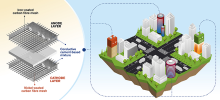
Buildings and bridges could be transformed into cheap batteries with the discovery of a new cement mixture, according to researchers.
A team at Lancaster University say they have created a new ‘smart’ cement mixture that can store electrical energy and monitor its own structural health. In addition to buildings and bridges, they claim that the mixture could also turn street lamps and curb-stones into batteries.
Made from flyash and chemical solutions, the potassium-geopolymetric (KGP) composites are claimed to be cheaper than Ordinary Portland Cement, the most widely used construction material. The researchers say they are easy to produce, and do not need any complex or expensive additives because conductivity is achieved by potassium ions hopping through the crystalline structure.
Alternative smart concretes rely on expensive additives such as graphene and carbon nano-tubes. The researchers state that, in addition to cost, these technologies do not scale up well preventing use in large structures.
The newly-created KGP composites rely on the diffusion of potassium ions within the structure to store electrical energy and to sense mechanical stresses. When fully optimised, KGP mixtures could have the potential to store and discharge between 200 and 500 watts per square metre.
It is claimed that a house with exterior or partition walls built using KGP, when connected to a power source such as solar panels, would be able to store power during the day when empty and discharge it during the evening when the occupiers are home. Existing buildings could have KGP panels retro-fitted.
Other uses for the smart cement could include taking street lighting off-grid. A typical street lamp post uses 700 watts each night. A six-metre tall lamppost made using KGP would hold enough renewable energy to power itself throughout the evening. KGP curb-stones could store energy to power smart street sensors monitoring traffic, drainage and pollution.
Large numbers of structures made with KGP could also be used to store and release excess energy – potentially smoothing demands on grids.
The researchers says that another key benefit is that the KGP mixtures are self-sensing. Changes in mechanical stress, caused by things such as cracks, alter the mechanism of ion hopping through the structure and therefore the material’s conductivity. These changes mean the structural health of buildings can be monitored automatically, by measuring conductivity, without the need for additional sensors.
Currently the structural health of buildings is monitored with routine visual checks. Structures that include sections made from KGP at critical stress points would provide accurate instantaneous alerts when structural defects, such as cracking, occur.
Professor Mohamed Saafi from Lancaster University’s Engineering Department, and lead author of the study, said: “We have shown for the first time that KGP cement mixtures can be used to store and deliver electrical energy without the need for expensive or hazardous additives.
“These cost-effective mixtures could be used as integral parts of buildings and other infrastructure as a cheap way to store and deliver renewable energy, powering street lighting, traffic lights and electric vehicle charging points.
“In addition, the concrete’s smart properties makes it useful to be used as sensors to monitor the structural health of buildings, bridges and roads.”
The researchers are now doing in-depth studies to optimise the performance of KGP mixtures and are also looking at 3D-printing as a way to use the cement to create different architectural shapes.
The research is outlined in a paper due to be published in the ‘Composite Structures’ journal on October 1.







